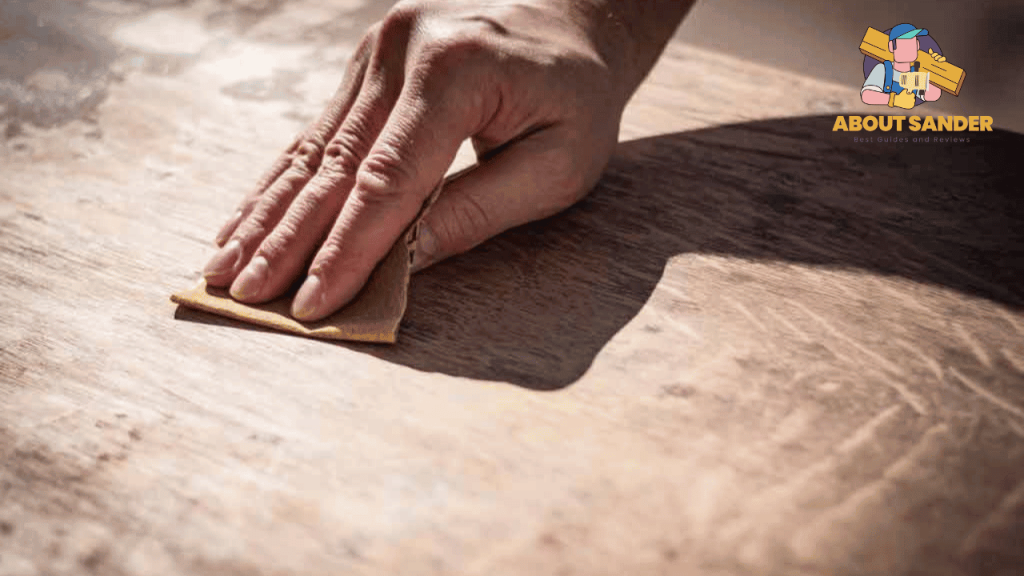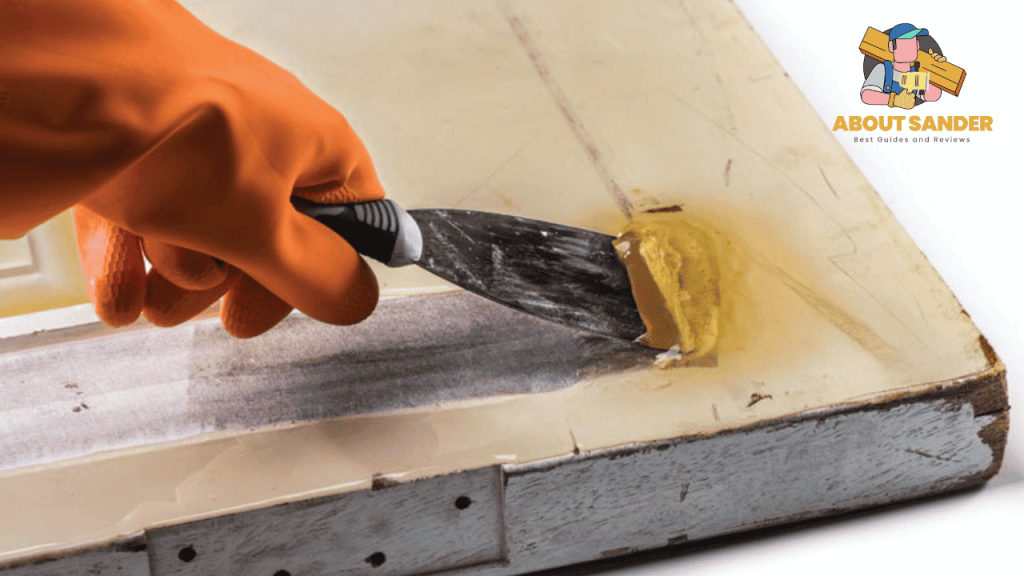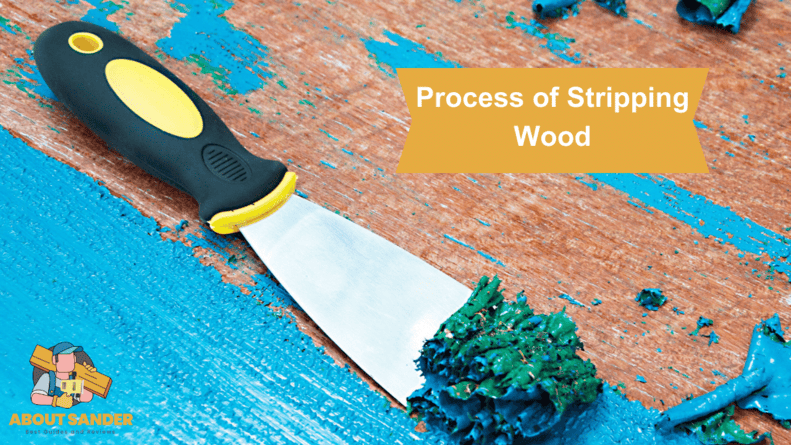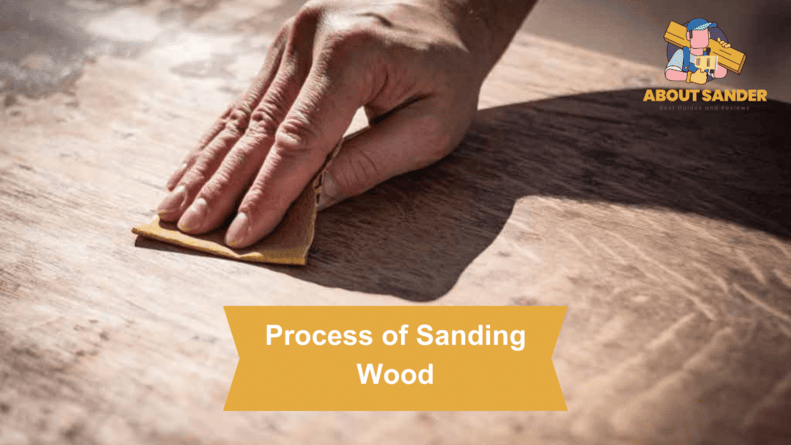Stripping vs sanding Wood is an age-old debate. Stripping is better for removing old finishes and paint, while sanding is ideal for surface preparation and smoothing.
Whether you want to remove old finishes or smooth out imperfections, understanding the critical differences between these methods is crucial.
Key Takeaways:


- Stripping Wood removes thick or stubborn coatings, while sanding allows for precise surface preparation.
- Sanding Wood requires more time and effort compared to stripping.
- Health and safety precautions are necessary for both stripping vs sanding Wood.
- Stripping Wood may raise environmental concerns due to the use and disposal of chemical solvents.
- Sanding offers greater versatility and adaptability to different wood types and surfaces.
- Skill and experience are required for both techniques, with sanding demanding higher precision.
- Cost considerations include purchasing materials and equipment, with stripping potentially being more costly.
- The choice between stripping and sanding depends on project requirements, such as the type of Wood, desired finish, and level of precision needed.
In this article, we’ll delve into the world of wood restoration and explore the benefits of stripping vs sanding Wood, helping you make an informed decision for your next project. So, let’s dive right into the stripping vs sanding wood debate and unlock the secrets to achieving stunning results.
The Ultimate Guide for Expert Restoration
When it comes to restoring the natural beauty of Wood, stripping is an invaluable asset in the arsenal of seasoned artisans. As experts in wood restoration, we understand the importance of choosing a suitable method for each project.
Process of Stripping Wood:

In the stripping vs sanding wood battle, stripping proves to be a powerful contender. This comprehensive guide will walk you through the step-by-step process of stripping vs sanding wood, shedding light on its advantages and showcasing why it is often the preferred choice for furniture, cabinets, doors, and more.
1- Preparation
Gathering Your Tools and Ensuring Safety Before embarking on any stripping project, it’s crucial to equip yourself with the necessary tools and ensure a safe working environment. Gather the following essentials:
- Chemical stripper (appropriate for the specific project)
- Safety goggles and gloves
- Respirator mask
- Drop cloths or plastic sheets
- Paintbrushes or chip brushes
- Scrapers of various sizes
- Steel wool or abrasive pads
- Clean rags or paper towels
2- Surface Preparation:
Removing Hardware and Protective Measures Begin by removing any hardware, such as handles or hinges, from the wood surface. This step allows for easier access and ensures no damage occurs to the hardware during the stripping process. Protect the surrounding area by laying down drop cloths or plastic sheets to catch any drips or debris.
3- Applying the Chemical Stripper:
With safety gear in place, it’s time to apply the chemical stripper to the wood surface. Using a paintbrush or chip brush, generously coat the Wood with the stripper, ensuring complete coverage. Allow the stripper to penetrate the existing finish, following the manufacturer’s recommended time frame.
4- Removing the Old Finish:
Gentle Persuasion Once the stripper has sufficient time to work its magic, you can remove the old finish. Using a scraper, carefully scrape away the softened finish, working toward the wood grain. Switch to smaller scrapers or even steel wool or abrasive pads for intricate or detailed surfaces to reach every nook and cranny.
5- Cleaning and Finishing Touches:
Revealing the Wood’s Beauty After successfully stripping away the old finish, thoroughly cleaning the wood surface is essential. Use clean rags or paper towels dampened with a mild solvent or water to remove any remaining stripper residue. This step helps to smoothen any raised wood fibres and prepares the surface for staining, painting, or applying a new finish.

5 Pros of Stripping Wood:
As an expert in wood restoration, I firmly believe that understanding the benefits of different techniques is crucial for achieving exceptional results. I will shed light on the pros of stripping vs sanding wood, demonstrating why it is the preferred choice for professionals regarding projects such as stripping paint from cabinets, restoring furniture, or rejuvenating doors.
1- Preservation of Wood Integrity:
With a gentle touch when stripping wood furniture or other wooden surfaces, one of the standout advantages is preserving wood integrity unlike sanding, which removes a layer of the Wood itself, stripping targets selectively and removes the old finish or paint while leaving the natural Wood intact.
2- Efficiency in Removing Multiple Layers:
Uncovering hidden beauty stripping wood excels when removing multiple layers of paint, varnish, or finishes. This technique penetrates deeply into the layers, softening and dissolving the coatings, making it easier to remove them. By stripping away these layers, you can uncover the hidden beauty of the Wood and restore it to its former glory.
3- Effective for Intricate and Detailed Surfaces:
Reaching every nook and cranny one of the challenges posed by sanding wood furniture or intricate surfaces is reaching every nook and cranny. Stripping, on the other hand, excels in this aspect. The chemical stripper can penetrate and dissolve the old finish, even in the most intricate carvings or detailed areas.
4- Versatility in Removing Various Finishes:
A solution for every project from polyurethane to varnish, paint to lacquer, stripping Wood provides a versatile solution for removing various finishes. Different chemical strippers are available on the market, each specifically formulated to tackle different types of coatings.
5- Time and Labor-Saving:
Swift restoration is at its best when restoring wood surfaces, time and labor are precious resources. Stripping Wood offers a time and labor-saving advantage compared to sanding. While sanding requires significant effort and can be time-consuming, stripping can quickly and effectively remove layers of old finish or paint.
5 Cons of Stripping Wood:
As an expert in wood restoration, providing a balanced perspective on different techniques is essential. In the ongoing debate of stripping vs sanding wood furniture, cabinets, and other surfaces, it is vital to understand the limitations of stripping. Join me as we delve into the challenges of stripping Wood and gain a comprehensive understanding of this expert technique.
1- Chemical Exposure and Safety Precautions:
Handling with care one of the primary downsides of stripping Wood is the potential exposure to chemicals and the need for safety precautions. Chemical strippers contain strong solvents that can emit harmful fumes. When working with these substances, it is vital to wear safety goggles, gloves, and a respirator mask to protect yourself from inhalation and skin contact.
2- Mess and Cleanup:
Tidying up the aftermath stripping wood can be messy, resulting in drips, spills, and debris. While dropping cloths or plastic sheets helps contain the mess, some residue may still find its way onto the surrounding area. Cleaning up the aftermath of stripping requires diligent effort, including wiping down surfaces, disposing of waste properly, and ensuring thorough cleaning of tools.
3- Limited Effectiveness on Certain Coatings:
The tough nuts to crack while stripping vs sanding wood is adequate for most finishes; there are instances where it may struggle to remove certain coatings. Some modern and specialized finishes, such as certain epoxy-based or powder-coated coatings, may resist the chemical stripper’s effects.
4- Potential Damage to Soft or Delicate Wood:
Handle with Care Another downside of stripping Wood is the potential for damage, particularly on softer or delicate wood species. While stripping is generally a gentle technique, there is a risk of inadvertently damaging the wood surface if excessive force or harsh scraping methods are employed.
5- Time and Labor Intensive:
Patience is key stripping wood can be a time and labor-intensive process, requiring patience and meticulous attention to detail. The chemical stripper needs sufficient time to penetrate and dissolve the old finish, and removing the softened coating may require multiple rounds of scraping.
Process of Sanding Wood:

As an expert in wood restoration, I understand the importance of choosing the proper technique to achieve remarkable results. In this comprehensive guide, I will walk you through the step-by-step process of sanding Wood, shedding light on its benefits and showcasing why it is a preferred choice for professionals. Join me as we uncover the secrets behind sanding Wood and discover how to achieve flawlessly restored surfaces.
1- Preparation:
Gathering essential tools and safety measures before diving into the sanding process, gathering the necessary tools, and ensuring a safe working environment is crucial. Here are the tools you will need:
- Sandpaper of varying grits (coarse to fine)
- Sanding block or power sander
- Safety goggles and a dust mask
- Vacuum or dust collection system
- Drop cloths or plastic sheets
- Tack cloth or clean rags
2- Surface Inspection and Cleaning:
Identifying Imperfections Begin by thoroughly inspecting the wood surface you plan to sand. Look for imperfections such as scratches, dents, or gouges that must be addressed before sanding. Use wood filler or putty to fill any holes or gaps. Once the repairs are complete, remove any hardware or fixtures from the wood surface.
3- Coarse Sanding:
Leveling the Surface Coarse sanding is the initial step in the sanding process, aimed at balancing the wood surface like sanding a door to fit and removing any unevenness or imperfections. Attach a coarse-grit sandpaper to your sanding block or power sander and begin sanding toward the wood grain. Apply even pressure, ensuring consistent sanding across the entire surface.
4- Fine Sanding:
Achieving a Silky Finish After completing the coarse sanding, transition to fine sanding to achieve a silky-smooth finish. Replace the coarse sandpaper with finer-grit sandpaper, and repeat the sanding process, again following the direction of the wood grain. Take your time during this phase, ensuring even sanding and paying attention to detail.
5- Cleaning and Finishing Touches:
Preparing for the Next Step Once the sanding process is complete, removing all dust and debris from the wood surface is essential. Use a vacuum or dust collection system to clean the area thoroughly. Then, wipe down the wood surface with a tack cloth or clean rag to remove any remaining particles.

5 Pros of Sanding Wood:
As an expert in wood restoration, I have witnessed the transformative power of sanding when rejuvenating furniture, cabinets, and other wooden surfaces. In this comprehensive guide, I will highlight the advantages of sanding Wood and demonstrate why it is the preferred technique for professionals in the field.
1- Surface Restoration:
Reclaiming the natural beauty one of the standout benefits of sanding wood is its ability to restore the surface to its natural beauty. Over time, wood surfaces can become worn, scratched, or marred by the effects of use and exposure.
2- Smoothing and Leveling:
Achieving a Flawless Canvas Sanding wood provides unparalleled control over the smoothing and leveling process. With the ability to choose different grits of sandpaper, sanding allows for the gradual removal of imperfections, ensuring a flawlessly smooth and level surface.
3- Smoothing and Leveling:
Tailoring the Results Sanding wood offers high precision and versatility, making it suitable for various projects. Different sandpaper grits can achieve specific effects depending on the desired outcome. Coarse-grit sandpaper efficiently removes deep scratches or rough surfaces, while finer-grit sandpaper provides a polished finish.
4- Enhanced Adhesion:
Preparing for the Next Step A significant benefit of sanding Wood is enhancing adhesion for subsequent processes such as staining, painting, or applying a protective finish. By removing the existing finish or roughening the surface, sanding creates a textured surface that promotes better adhesion.
5- Cost-Effective and Efficient:
Maximizing Results When considering the cost-effectiveness and Efficiency of wood restoration, sanding emerges as a clear winner. Unlike stripping, which may require the purchase of specialized chemical strippers or additional equipment, sanding primarily relies on readily available sandpaper and tools.
5 Cons of Sanding Wood:
As an expert in wood restoration, I am well-versed in the advantages and limitations of various techniques. When stripping vs sanding wood furniture, cabinets, or other surfaces, it is crucial to have a comprehensive understanding of the downsides of sanding.
1- Dust and Debris:
Managing the Mess, One of the primary downsides of sanding Wood is the creation of dust and debris. Sanding wood surfaces generates fine particles that can become airborne and settle on surrounding objects. This can result in a messy workspace and require additional cleaning efforts to ensure a tidy environment.
2- Potential Damage to Wood:
Proceed with Caution. While sanding Wood can yield exceptional results when executed properly, there is a risk of causing damage without Care. Excessive sanding or improper techniques can result in uneven surfaces, over-sanding in certain areas, or even sanding through thin veneers.
3- Time and Labor-Intensive:
Patience is key sanding wood can be a time and labor-intensive process, especially for larger or more intricate projects. Achieving a smooth and flawless surface often requires multiple rounds of sanding with different grits of sandpaper, which can be time-consuming. Investigating the inherent time and effort needed when planning a sanding project is essential.
4- Limited Effectiveness on Deep Stains or Coatings:
A Challenging Task While sanding, Wood effectively removes surface-level stains or finishes. It may need to be more successful in tackling deep stains or heavily applied coatings. In cases where Wood has absorbed deep colors or thick layers of paint or varnish are present, sanding alone may not be sufficient to achieve the desired results.
5- Health and Safety Considerations:
Protecting Yourself, Sanding Wood poses potential health and safety risks that must be addressed. The process generates airborne dust particles that can be hazardous if inhaled. Wearing a dust mask or respirator to protect your respiratory system is crucial.
Stripping vs Sanding Wood: A Comprehensive Comparison

As an expert in wood restoration, I understand the importance of choosing the proper technique for achieving optimal results. Both methods have their unique advantages and considerations. In this comprehensive comparison guide, We will delve into the intricacies of stripping vs sanding Wood, allowing you to decide based on your specific project requirements.
1- Purpose and Effectiveness:
Removing Paint and Stains Stripping Wood involves using chemical solvents or heat to dissolve or soften paint, varnish, or other coatings, making them easier to remove. While sanding is generally adequate for surface-level removal, it may be less efficient in removing deeply embedded stains or multiple layers of coating.
2- Precision and Control:
Surface Preparation Regarding precision and control over surface preparation, sanding Wood offers greater flexibility. Sanding allows for the gradual and targeted removal of imperfections, ensuring a smoother and more even surface. Stripping, although effective in removing coatings, may need to be more precise and require additional steps to achieve the desired smoothness.
3- Precision and Control:
Speed and Efficiency Regarding time and effort, sanding Wood generally requires more labour and time investment than stripping. Sanding involves multiple stages with different grits of sandpaper to achieve a polished finish. On the other hand, stripping can be a faster method for removing paint or finishes when done correctly.
4- Health and Safety Considerations:
Hazards and Precautions When comparing stripping vs sanding Wood, health and safety considerations are crucial. Stripping Wood often involves the use of chemical solvents or heat. Sanding Wood generates airborne dust particles, requiring dust masks, eye protection, and proper dust collection systems to minimize health risks.
5- Environmental Impact:
Chemicals and Waste Disposal Regarding environmental impact, stripping Wood may raise concerns regarding the use and disposal of chemical solvents. Sanding Wood, although it produces dust, does not involve chemical substances, making it a more environmentally friendly option.
6- Versatility:
Surface Adaptability Sanding wood offers greater versatility when it comes to surface adaptability. It can be employed on various wood types, including soft and hardwoods and furniture or architectural elements. Stripping Wood, however, may have limitations depending on the finish type or coating to remove.
7- Skill and Experience:
Expertise Required (continued) Both stripping and sanding Wood require skill and experience to achieve desired results. However, stripping may be more forgiving to beginners as it relies on applying chemical solvents or heat. Sanding, however, demands a higher level of precision and control.
8- Cost Considerations:
Materials and Equipment Cost considerations are significant when choosing between stripping and sanding Wood. Stripping may require the purchase of chemical solvents or heat tools, adding to the overall cost. In contrast, sanding primarily relies on sandpaper and essential tools like sanding blocks or orbital sanders, which are generally more affordable and readily available.
FAQs
Choosing strip vs sanding wood can be a common dilemma regarding restoration and refinishing. To help clear up any confusion, here are answers to some frequently asked questions about stripping vs sanding wood furniture, cabinets, and other surfaces.
What is the main difference between stripping and sanding Wood?
Stripping involves using chemical solvents or heat to remove paint, varnish, or other coatings, while sanding physically abrades the surface using sandpaper to remove imperfections. Stripping focuses on dissolving or softening the layers, while sanding relies on abrasion to achieve a smoother finish.
Which technique is more suitable for removing paint from cabinets?
When removing paint from cabinets, stripping is often more effective, especially when dealing with multiple layers or stubborn finishes. Stripping products or heat methods are designed to dissolve or soften the paint, making removing it easier.
Which technique is better for preserving intricate details on wood furniture?
Sanding is generally better for preserving intricate details on wood furniture. It allows for more precision and control, allowing you to sand around intricate designs or hard-to-reach areas carefully. Sanding with different grits of sandpaper enables you to achieve a polished finish while maintaining the fine details of the furniture.
Which chemical is used for stripping?
The chemical commonly used for stripping is methylene chloride (dichloromethane).
Does sanding damaged wood?
Sanding can damage the wood if not done correctly or excessively, as it removes the protective layers and can lead to uneven surfaces or thinning of the wood.
Conclusion
In conclusion, the debate on stripping vs sanding wood or other surfaces ultimately comes down to project-specific requirements and personal preferences. Consider factors such as the type of Wood, desired finish, level of detail, time investment, environmental impact, and cost when deciding.

Why Trust About Sanders?
When it comes to the world of sanding and sanders, you need a trusted source of information and guidance to ensure you achieve those perfect finishes. That's where I come in – I'm Martin, a dedicated sanding enthusiast with a relentless passion for attaining flawless surfaces. With years of hands-on experience in the sanding industry, I've honed my skills and expertise to provide you with the most reliable and accurate insights. What sets me apart is my commitment to excellence. I meticulously handpick each sander after rigorous testing, ensuring that only the best tools make it to your hands. My goal is to empower you with the knowledge and recommendations you need to tackle any sanding task confidently. When you trust About Sanders, you're putting your faith in a seasoned expert who shares your passion for perfection and strives to deliver top-notch information and reviews for every sanding challenge.
